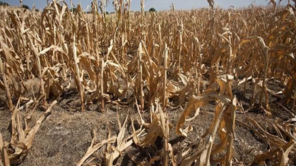Over 57% of the Masovian voivodeship is located within a belt where there is a serious and extreme threat of agricultural drought. At the same time, the area of about 30% of Masovian rivers, lakes and reservoirs is stated to be seriously threatened with hydrological drought. Measures of counteracting these phenomena were a topic of discussion on 4 February in Warsaw.
The debate concluded the six months of public consultations on the Drought Effects Counteracting Plan (DECP). Notes and comments on the DECP can be submitted until 15 February. Over 300 have been submitted so far.
The scale of the hydrological drought and the consequences could have been seen in the previous year on the Vistula, which had record low flows. The agricultural drought threat level, in turn, is illustrated on the map (agricultural threat level estimated on the basis of long-term data from 1997–2018):
Water resources of the Masovian region are used heavily – the intensive exploitation of available river water resources is relevant to over 73% of basins in the region. The utilisation of available groundwater resources is at 18.5%. During droughts, the resources dwindle; therefore, the scale of the problem with water availability becomes more and more serious. An important aspect of counteracting drought effects involves securing adequate renewability of groundwater resources, by fulfilling requirements for water retention so that rain or snow could supply rivers and groundwater. A characteristic feature of the local climate is the snowfall in winter. Based on long-term analyses, it gradually becomes less intensive. This January in Warsaw was unprecedented in terms of snowless winter days, according to the data of the Institute of Meteorology and Water Management. Snow fell only on 29 January – previously, the latest historic snowfall occurred on 24 January in 2007. At the end of January this year, the snow only covered about a third of the country’s area, whereas it should have covered at least half of Poland’s territory and lasted longer than currently in order to retain the soil moisture necessary for arable crops’ growth. Also, the rainfall is record low. Experts from the National Water Management Authority are certain that this increasing trend is associated with climate change. In the last 5 years there were 3 years with drought, each time involving all its types (agricultural, hydrological, hydrogeological). Furthermore, droughts span over an increasingly large area of the country and the losses they inflict become greater as well.
– There is an urgent need for developing a plan for counteracting the effects of drought as the frequency of dry spells keeps growing. Public consultations constitute a crucial stage in the development of the plan. They were in effect for 6 months, giving everyone a chance to express their thoughts on this exceptionally important issue. We are nearing the final stages of developing the document – today is the last, fifteenth consultation meeting. I am pleased with the active participation of the public in the development of the DECP project and the attendance at the previous consultation meetings. Fourteen meetings in various parts of Poland attracted over a thousand representatives of institutions and organisations concerned with water management. So far, over 300 notes and comments have been submitted. The construction and reconstruction of retention tanks were found to be the most interesting among the discussed issues. At the same time, I would like to emphasize that the Drought Effects Counteracting Plan is expected to be adopted by the end of the current year in the form of a regulation – it will be in force for 6 years until its revision – explains Marek Gróbarczyk, Minister of Maritime Economy and Inland Waterway Transport.
The Masovian list of investments contains, among others, the adjustment of the transverse and longitudinal cross-section of the Bętlewianka river in order to increase the retention capacity at lower water levels, and renovation and maintenance work in other relatively small but locally significant facilities. – The advantage of these projects is the relatively short, two-year deadline for implementing the investment. We also encourage undertakings of a smaller scale to be a part of the DECP project. Clearing neglected drainage ditches, building ponds, small reservoirs near homes or in croplands are also an important element of investment works outlined in the document. Only through the completion of many such partial tasks all over the country will we be able to successfully counteract drought – said Przemysław Daca, President of the National Water Management Authority.
– Let us not forget that the project being consulted today in Warsaw, in accordance with the Water Law Act, does not involve merely investments but also a range of other undertakings of various character implemented both by Polish Waters as well as national and local administration units – he added. The execution of a part of the intended activities of the DECP will also require the involvement of entrepreneurs and individual water users. The catalogue of activities highlighted the development of mechanisms for financing activities for years 2021–2027.
Since 15 August 2019, consultation meetings on the DECP project have taken place in 15 cities (detailed information are available at www.stopsuszy.pl). The DECP is the first such comprehensive project on counteracting the effects of drought in Poland. Information about the DECP project is available at: www.stopsuszy.pl and www.konsultacjesusza.pl Until February 15, you can also submit comments and insights to the DECP project using a special form.
The DECP document, which will be the most important outcome of the Stop Drought Now! project, as well as the water and flood risk management plans, will greatly contribute to improving the water management processes in Poland. Following the public consultations, the DECP project will undergo a strategic environmental impact assessment. The final step in 2020 will be to formally adopt the project via a regulation prepared by the minister responsible for water management. At that point, Poland will join the group of 10 European countries that have developed drought countermeasure plans. Similar projects have already been implemented by such countries as the United Kingdom, France, Spain, Portugal, Slovakia and Ukraine.
The President of the National Water Management Authority is obliged to prepare the drought effects counteracting plan under the provisions of the Art. 240(2) (8) of the Act of 20 July 2017 – Water Law (Journal of Laws of 2018, item 2268, as amended). So far, as part of the Stop Drought Now! project, a DECP preparation methodology was created, and a survey of 3,500 entities related to water management was conducted. In addition, the draft plan of the project was presented at national expert conferences, public consultations and as part of the “Remember about water!” social campaign. All works are financed by European funds (OPI&E 2014–2020).
Find out more here: www.stopsuszy.pl, www.wody.gov.pl i www.konsultacjesusza.pl




Знакомства на Loveawake.Ru
Знакомства на Loveawake.Ru!..